MSc Supply Chain Finance: Competition in Fintech Analysis Report
VerifiedAdded on 2022/09/07
|11
|3094
|17
Report
AI Summary
This report examines the competitive dynamics within the Fintech industry, specifically focusing on supply chain finance. It analyzes the strategies employed by various companies to gain a competitive edge in this rapidly evolving sector. The report delves into the value proposition of Monimove, a prominent corporate supply chain finance platform, highlighting its features and advantages for both buyers and sellers. It explores the use of reverse factoring, working capital management, and strategic partnerships within the Fintech ecosystem. The analysis covers key aspects such as the company's approach to payment processing, risk mitigation, and its differentiation from competitors. The report also provides recommendations based on the findings, offering insights into the future of Fintech in supply chain finance.
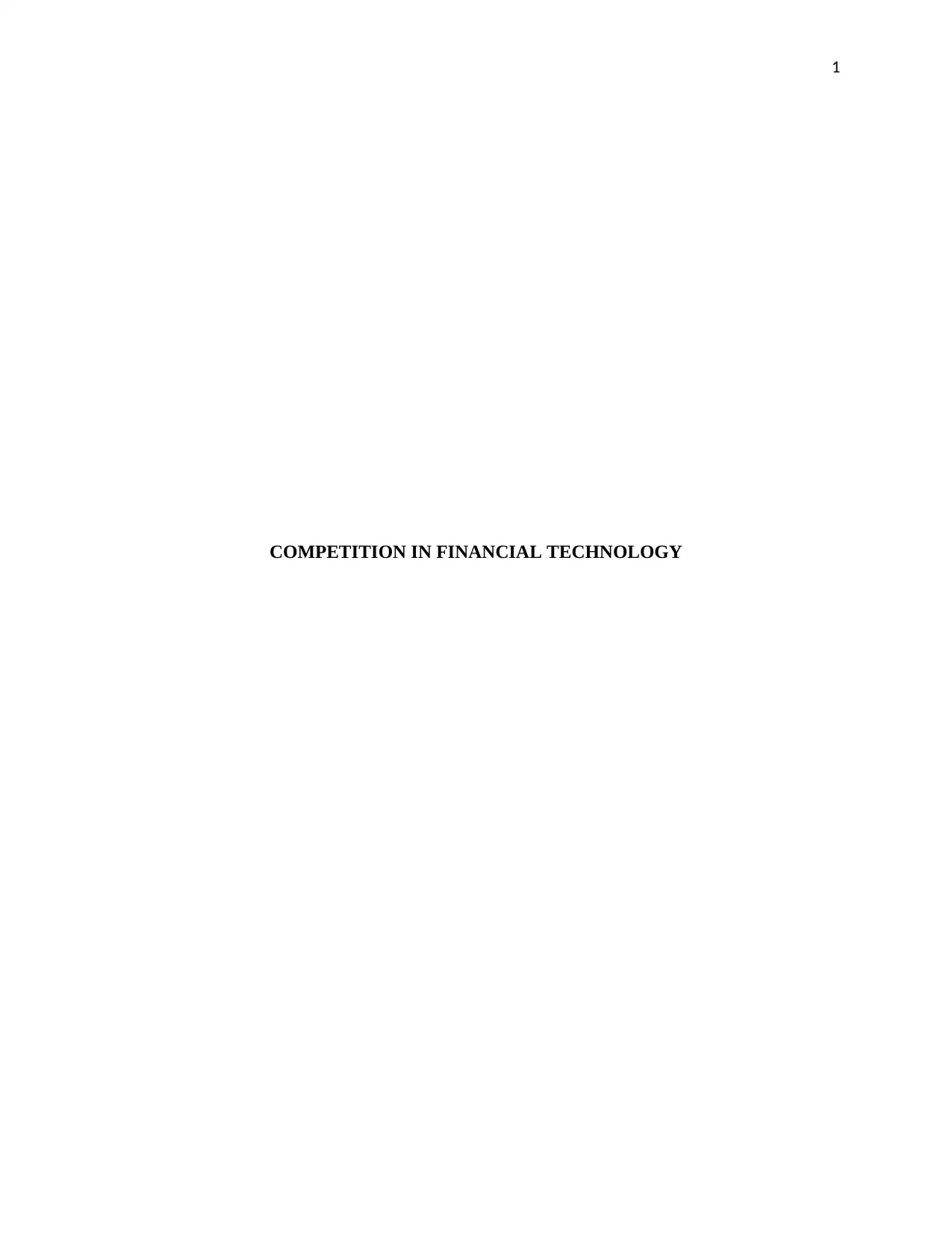
1
COMPETITION IN FINANCIAL TECHNOLOGY
COMPETITION IN FINANCIAL TECHNOLOGY
Paraphrase This Document
Need a fresh take? Get an instant paraphrase of this document with our AI Paraphraser
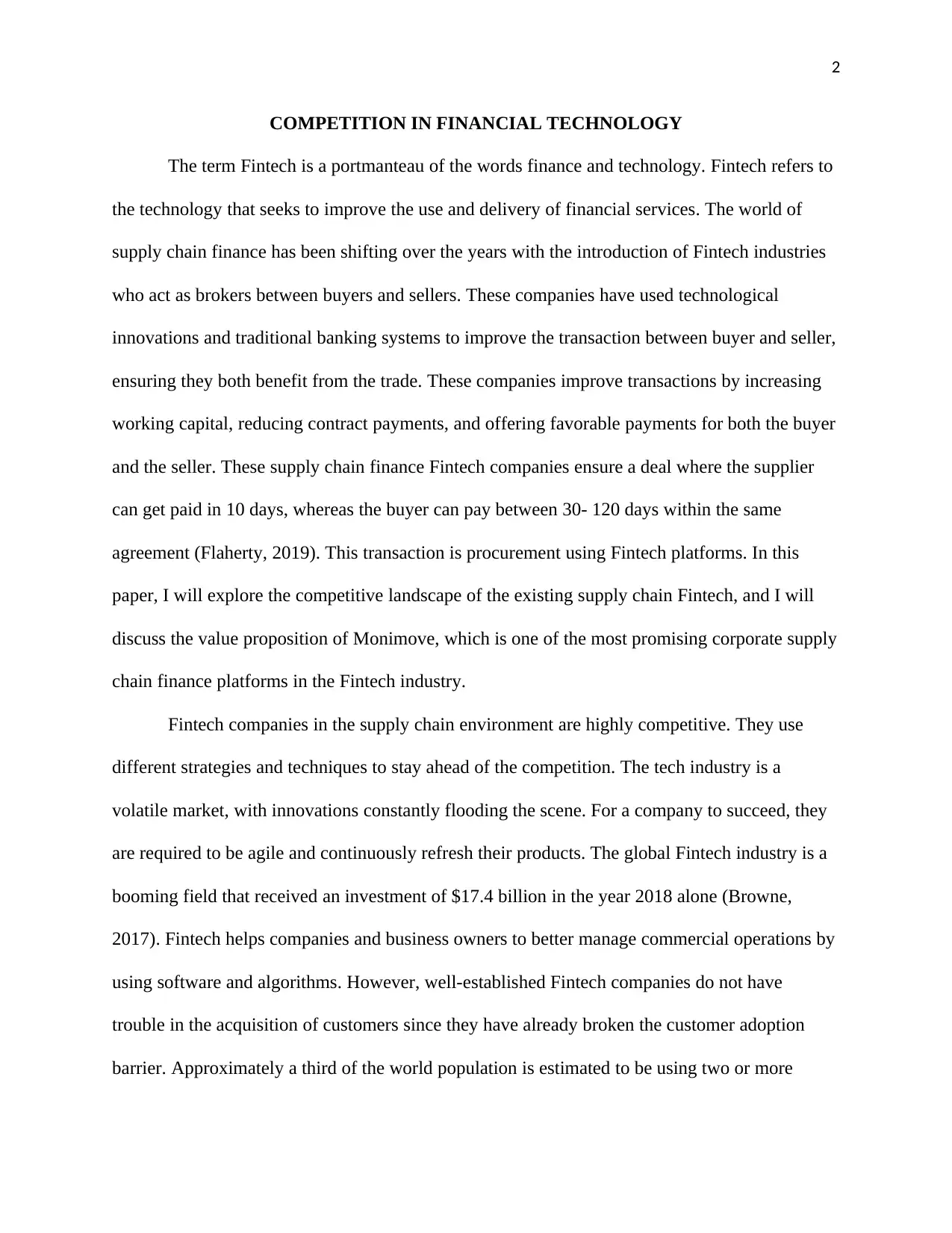
2
COMPETITION IN FINANCIAL TECHNOLOGY
The term Fintech is a portmanteau of the words finance and technology. Fintech refers to
the technology that seeks to improve the use and delivery of financial services. The world of
supply chain finance has been shifting over the years with the introduction of Fintech industries
who act as brokers between buyers and sellers. These companies have used technological
innovations and traditional banking systems to improve the transaction between buyer and seller,
ensuring they both benefit from the trade. These companies improve transactions by increasing
working capital, reducing contract payments, and offering favorable payments for both the buyer
and the seller. These supply chain finance Fintech companies ensure a deal where the supplier
can get paid in 10 days, whereas the buyer can pay between 30- 120 days within the same
agreement (Flaherty, 2019). This transaction is procurement using Fintech platforms. In this
paper, I will explore the competitive landscape of the existing supply chain Fintech, and I will
discuss the value proposition of Monimove, which is one of the most promising corporate supply
chain finance platforms in the Fintech industry.
Fintech companies in the supply chain environment are highly competitive. They use
different strategies and techniques to stay ahead of the competition. The tech industry is a
volatile market, with innovations constantly flooding the scene. For a company to succeed, they
are required to be agile and continuously refresh their products. The global Fintech industry is a
booming field that received an investment of $17.4 billion in the year 2018 alone (Browne,
2017). Fintech helps companies and business owners to better manage commercial operations by
using software and algorithms. However, well-established Fintech companies do not have
trouble in the acquisition of customers since they have already broken the customer adoption
barrier. Approximately a third of the world population is estimated to be using two or more
COMPETITION IN FINANCIAL TECHNOLOGY
The term Fintech is a portmanteau of the words finance and technology. Fintech refers to
the technology that seeks to improve the use and delivery of financial services. The world of
supply chain finance has been shifting over the years with the introduction of Fintech industries
who act as brokers between buyers and sellers. These companies have used technological
innovations and traditional banking systems to improve the transaction between buyer and seller,
ensuring they both benefit from the trade. These companies improve transactions by increasing
working capital, reducing contract payments, and offering favorable payments for both the buyer
and the seller. These supply chain finance Fintech companies ensure a deal where the supplier
can get paid in 10 days, whereas the buyer can pay between 30- 120 days within the same
agreement (Flaherty, 2019). This transaction is procurement using Fintech platforms. In this
paper, I will explore the competitive landscape of the existing supply chain Fintech, and I will
discuss the value proposition of Monimove, which is one of the most promising corporate supply
chain finance platforms in the Fintech industry.
Fintech companies in the supply chain environment are highly competitive. They use
different strategies and techniques to stay ahead of the competition. The tech industry is a
volatile market, with innovations constantly flooding the scene. For a company to succeed, they
are required to be agile and continuously refresh their products. The global Fintech industry is a
booming field that received an investment of $17.4 billion in the year 2018 alone (Browne,
2017). Fintech helps companies and business owners to better manage commercial operations by
using software and algorithms. However, well-established Fintech companies do not have
trouble in the acquisition of customers since they have already broken the customer adoption
barrier. Approximately a third of the world population is estimated to be using two or more
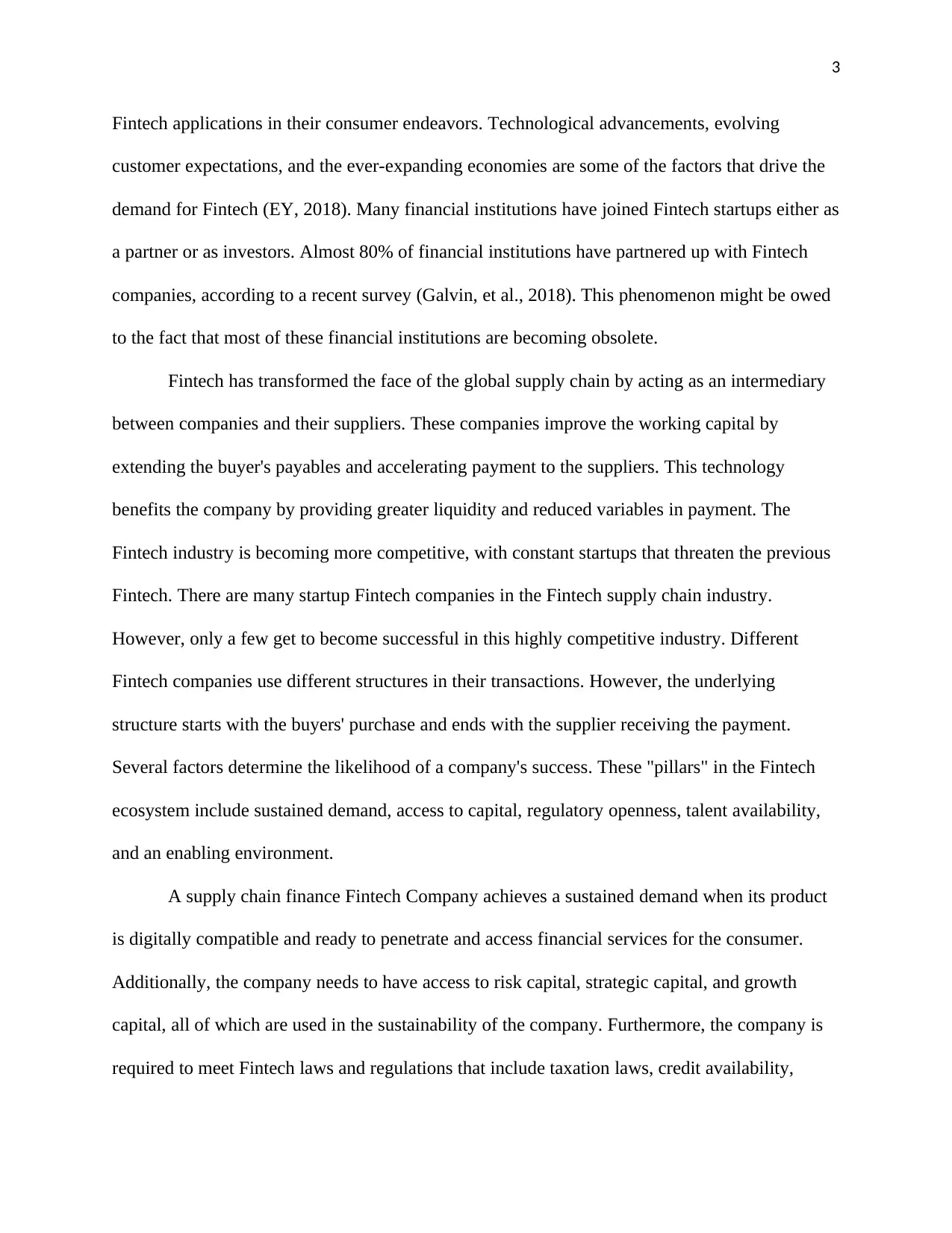
3
Fintech applications in their consumer endeavors. Technological advancements, evolving
customer expectations, and the ever-expanding economies are some of the factors that drive the
demand for Fintech (EY, 2018). Many financial institutions have joined Fintech startups either as
a partner or as investors. Almost 80% of financial institutions have partnered up with Fintech
companies, according to a recent survey (Galvin, et al., 2018). This phenomenon might be owed
to the fact that most of these financial institutions are becoming obsolete.
Fintech has transformed the face of the global supply chain by acting as an intermediary
between companies and their suppliers. These companies improve the working capital by
extending the buyer's payables and accelerating payment to the suppliers. This technology
benefits the company by providing greater liquidity and reduced variables in payment. The
Fintech industry is becoming more competitive, with constant startups that threaten the previous
Fintech. There are many startup Fintech companies in the Fintech supply chain industry.
However, only a few get to become successful in this highly competitive industry. Different
Fintech companies use different structures in their transactions. However, the underlying
structure starts with the buyers' purchase and ends with the supplier receiving the payment.
Several factors determine the likelihood of a company's success. These "pillars" in the Fintech
ecosystem include sustained demand, access to capital, regulatory openness, talent availability,
and an enabling environment.
A supply chain finance Fintech Company achieves a sustained demand when its product
is digitally compatible and ready to penetrate and access financial services for the consumer.
Additionally, the company needs to have access to risk capital, strategic capital, and growth
capital, all of which are used in the sustainability of the company. Furthermore, the company is
required to meet Fintech laws and regulations that include taxation laws, credit availability,
Fintech applications in their consumer endeavors. Technological advancements, evolving
customer expectations, and the ever-expanding economies are some of the factors that drive the
demand for Fintech (EY, 2018). Many financial institutions have joined Fintech startups either as
a partner or as investors. Almost 80% of financial institutions have partnered up with Fintech
companies, according to a recent survey (Galvin, et al., 2018). This phenomenon might be owed
to the fact that most of these financial institutions are becoming obsolete.
Fintech has transformed the face of the global supply chain by acting as an intermediary
between companies and their suppliers. These companies improve the working capital by
extending the buyer's payables and accelerating payment to the suppliers. This technology
benefits the company by providing greater liquidity and reduced variables in payment. The
Fintech industry is becoming more competitive, with constant startups that threaten the previous
Fintech. There are many startup Fintech companies in the Fintech supply chain industry.
However, only a few get to become successful in this highly competitive industry. Different
Fintech companies use different structures in their transactions. However, the underlying
structure starts with the buyers' purchase and ends with the supplier receiving the payment.
Several factors determine the likelihood of a company's success. These "pillars" in the Fintech
ecosystem include sustained demand, access to capital, regulatory openness, talent availability,
and an enabling environment.
A supply chain finance Fintech Company achieves a sustained demand when its product
is digitally compatible and ready to penetrate and access financial services for the consumer.
Additionally, the company needs to have access to risk capital, strategic capital, and growth
capital, all of which are used in the sustainability of the company. Furthermore, the company is
required to meet Fintech laws and regulations that include taxation laws, credit availability,
⊘ This is a preview!⊘
Do you want full access?
Subscribe today to unlock all pages.

Trusted by 1+ million students worldwide
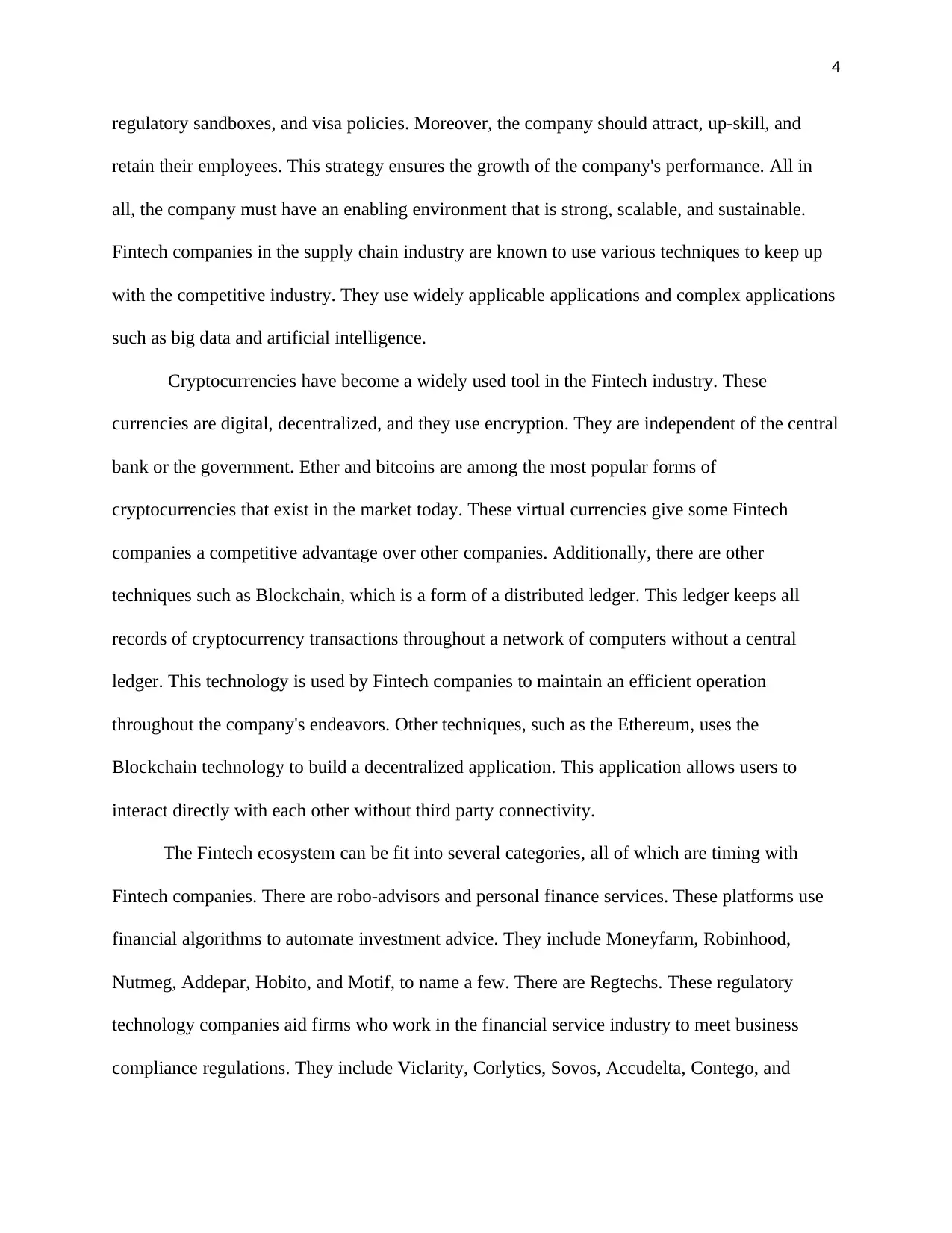
4
regulatory sandboxes, and visa policies. Moreover, the company should attract, up-skill, and
retain their employees. This strategy ensures the growth of the company's performance. All in
all, the company must have an enabling environment that is strong, scalable, and sustainable.
Fintech companies in the supply chain industry are known to use various techniques to keep up
with the competitive industry. They use widely applicable applications and complex applications
such as big data and artificial intelligence.
Cryptocurrencies have become a widely used tool in the Fintech industry. These
currencies are digital, decentralized, and they use encryption. They are independent of the central
bank or the government. Ether and bitcoins are among the most popular forms of
cryptocurrencies that exist in the market today. These virtual currencies give some Fintech
companies a competitive advantage over other companies. Additionally, there are other
techniques such as Blockchain, which is a form of a distributed ledger. This ledger keeps all
records of cryptocurrency transactions throughout a network of computers without a central
ledger. This technology is used by Fintech companies to maintain an efficient operation
throughout the company's endeavors. Other techniques, such as the Ethereum, uses the
Blockchain technology to build a decentralized application. This application allows users to
interact directly with each other without third party connectivity.
The Fintech ecosystem can be fit into several categories, all of which are timing with
Fintech companies. There are robo-advisors and personal finance services. These platforms use
financial algorithms to automate investment advice. They include Moneyfarm, Robinhood,
Nutmeg, Addepar, Hobito, and Motif, to name a few. There are Regtechs. These regulatory
technology companies aid firms who work in the financial service industry to meet business
compliance regulations. They include Viclarity, Corlytics, Sovos, Accudelta, Contego, and
regulatory sandboxes, and visa policies. Moreover, the company should attract, up-skill, and
retain their employees. This strategy ensures the growth of the company's performance. All in
all, the company must have an enabling environment that is strong, scalable, and sustainable.
Fintech companies in the supply chain industry are known to use various techniques to keep up
with the competitive industry. They use widely applicable applications and complex applications
such as big data and artificial intelligence.
Cryptocurrencies have become a widely used tool in the Fintech industry. These
currencies are digital, decentralized, and they use encryption. They are independent of the central
bank or the government. Ether and bitcoins are among the most popular forms of
cryptocurrencies that exist in the market today. These virtual currencies give some Fintech
companies a competitive advantage over other companies. Additionally, there are other
techniques such as Blockchain, which is a form of a distributed ledger. This ledger keeps all
records of cryptocurrency transactions throughout a network of computers without a central
ledger. This technology is used by Fintech companies to maintain an efficient operation
throughout the company's endeavors. Other techniques, such as the Ethereum, uses the
Blockchain technology to build a decentralized application. This application allows users to
interact directly with each other without third party connectivity.
The Fintech ecosystem can be fit into several categories, all of which are timing with
Fintech companies. There are robo-advisors and personal finance services. These platforms use
financial algorithms to automate investment advice. They include Moneyfarm, Robinhood,
Nutmeg, Addepar, Hobito, and Motif, to name a few. There are Regtechs. These regulatory
technology companies aid firms who work in the financial service industry to meet business
compliance regulations. They include Viclarity, Corlytics, Sovos, Accudelta, Contego, and
Paraphrase This Document
Need a fresh take? Get an instant paraphrase of this document with our AI Paraphraser
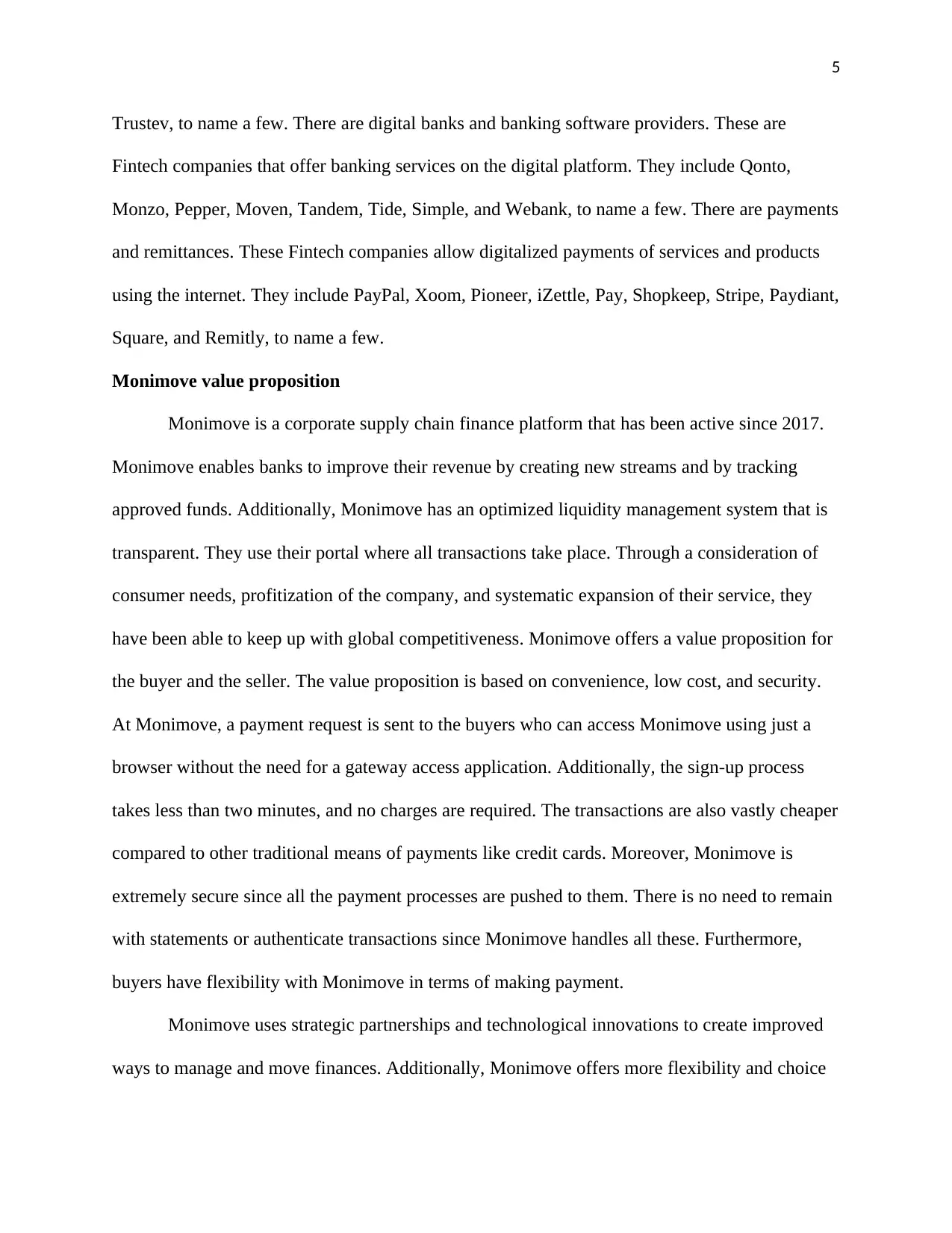
5
Trustev, to name a few. There are digital banks and banking software providers. These are
Fintech companies that offer banking services on the digital platform. They include Qonto,
Monzo, Pepper, Moven, Tandem, Tide, Simple, and Webank, to name a few. There are payments
and remittances. These Fintech companies allow digitalized payments of services and products
using the internet. They include PayPal, Xoom, Pioneer, iZettle, Pay, Shopkeep, Stripe, Paydiant,
Square, and Remitly, to name a few.
Monimove value proposition
Monimove is a corporate supply chain finance platform that has been active since 2017.
Monimove enables banks to improve their revenue by creating new streams and by tracking
approved funds. Additionally, Monimove has an optimized liquidity management system that is
transparent. They use their portal where all transactions take place. Through a consideration of
consumer needs, profitization of the company, and systematic expansion of their service, they
have been able to keep up with global competitiveness. Monimove offers a value proposition for
the buyer and the seller. The value proposition is based on convenience, low cost, and security.
At Monimove, a payment request is sent to the buyers who can access Monimove using just a
browser without the need for a gateway access application. Additionally, the sign-up process
takes less than two minutes, and no charges are required. The transactions are also vastly cheaper
compared to other traditional means of payments like credit cards. Moreover, Monimove is
extremely secure since all the payment processes are pushed to them. There is no need to remain
with statements or authenticate transactions since Monimove handles all these. Furthermore,
buyers have flexibility with Monimove in terms of making payment.
Monimove uses strategic partnerships and technological innovations to create improved
ways to manage and move finances. Additionally, Monimove offers more flexibility and choice
Trustev, to name a few. There are digital banks and banking software providers. These are
Fintech companies that offer banking services on the digital platform. They include Qonto,
Monzo, Pepper, Moven, Tandem, Tide, Simple, and Webank, to name a few. There are payments
and remittances. These Fintech companies allow digitalized payments of services and products
using the internet. They include PayPal, Xoom, Pioneer, iZettle, Pay, Shopkeep, Stripe, Paydiant,
Square, and Remitly, to name a few.
Monimove value proposition
Monimove is a corporate supply chain finance platform that has been active since 2017.
Monimove enables banks to improve their revenue by creating new streams and by tracking
approved funds. Additionally, Monimove has an optimized liquidity management system that is
transparent. They use their portal where all transactions take place. Through a consideration of
consumer needs, profitization of the company, and systematic expansion of their service, they
have been able to keep up with global competitiveness. Monimove offers a value proposition for
the buyer and the seller. The value proposition is based on convenience, low cost, and security.
At Monimove, a payment request is sent to the buyers who can access Monimove using just a
browser without the need for a gateway access application. Additionally, the sign-up process
takes less than two minutes, and no charges are required. The transactions are also vastly cheaper
compared to other traditional means of payments like credit cards. Moreover, Monimove is
extremely secure since all the payment processes are pushed to them. There is no need to remain
with statements or authenticate transactions since Monimove handles all these. Furthermore,
buyers have flexibility with Monimove in terms of making payment.
Monimove uses strategic partnerships and technological innovations to create improved
ways to manage and move finances. Additionally, Monimove offers more flexibility and choice
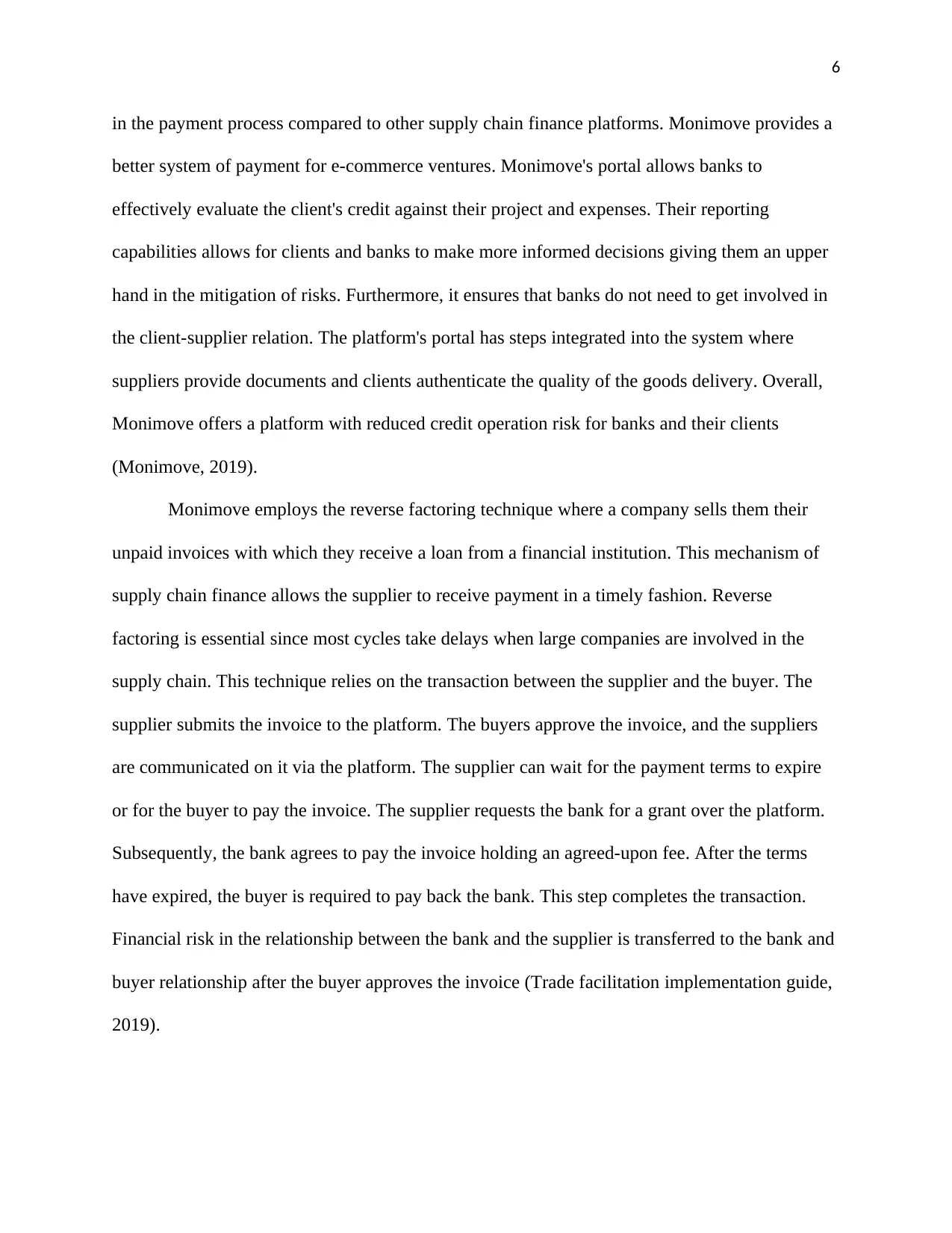
6
in the payment process compared to other supply chain finance platforms. Monimove provides a
better system of payment for e-commerce ventures. Monimove's portal allows banks to
effectively evaluate the client's credit against their project and expenses. Their reporting
capabilities allows for clients and banks to make more informed decisions giving them an upper
hand in the mitigation of risks. Furthermore, it ensures that banks do not need to get involved in
the client-supplier relation. The platform's portal has steps integrated into the system where
suppliers provide documents and clients authenticate the quality of the goods delivery. Overall,
Monimove offers a platform with reduced credit operation risk for banks and their clients
(Monimove, 2019).
Monimove employs the reverse factoring technique where a company sells them their
unpaid invoices with which they receive a loan from a financial institution. This mechanism of
supply chain finance allows the supplier to receive payment in a timely fashion. Reverse
factoring is essential since most cycles take delays when large companies are involved in the
supply chain. This technique relies on the transaction between the supplier and the buyer. The
supplier submits the invoice to the platform. The buyers approve the invoice, and the suppliers
are communicated on it via the platform. The supplier can wait for the payment terms to expire
or for the buyer to pay the invoice. The supplier requests the bank for a grant over the platform.
Subsequently, the bank agrees to pay the invoice holding an agreed-upon fee. After the terms
have expired, the buyer is required to pay back the bank. This step completes the transaction.
Financial risk in the relationship between the bank and the supplier is transferred to the bank and
buyer relationship after the buyer approves the invoice (Trade facilitation implementation guide,
2019).
in the payment process compared to other supply chain finance platforms. Monimove provides a
better system of payment for e-commerce ventures. Monimove's portal allows banks to
effectively evaluate the client's credit against their project and expenses. Their reporting
capabilities allows for clients and banks to make more informed decisions giving them an upper
hand in the mitigation of risks. Furthermore, it ensures that banks do not need to get involved in
the client-supplier relation. The platform's portal has steps integrated into the system where
suppliers provide documents and clients authenticate the quality of the goods delivery. Overall,
Monimove offers a platform with reduced credit operation risk for banks and their clients
(Monimove, 2019).
Monimove employs the reverse factoring technique where a company sells them their
unpaid invoices with which they receive a loan from a financial institution. This mechanism of
supply chain finance allows the supplier to receive payment in a timely fashion. Reverse
factoring is essential since most cycles take delays when large companies are involved in the
supply chain. This technique relies on the transaction between the supplier and the buyer. The
supplier submits the invoice to the platform. The buyers approve the invoice, and the suppliers
are communicated on it via the platform. The supplier can wait for the payment terms to expire
or for the buyer to pay the invoice. The supplier requests the bank for a grant over the platform.
Subsequently, the bank agrees to pay the invoice holding an agreed-upon fee. After the terms
have expired, the buyer is required to pay back the bank. This step completes the transaction.
Financial risk in the relationship between the bank and the supplier is transferred to the bank and
buyer relationship after the buyer approves the invoice (Trade facilitation implementation guide,
2019).
⊘ This is a preview!⊘
Do you want full access?
Subscribe today to unlock all pages.

Trusted by 1+ million students worldwide
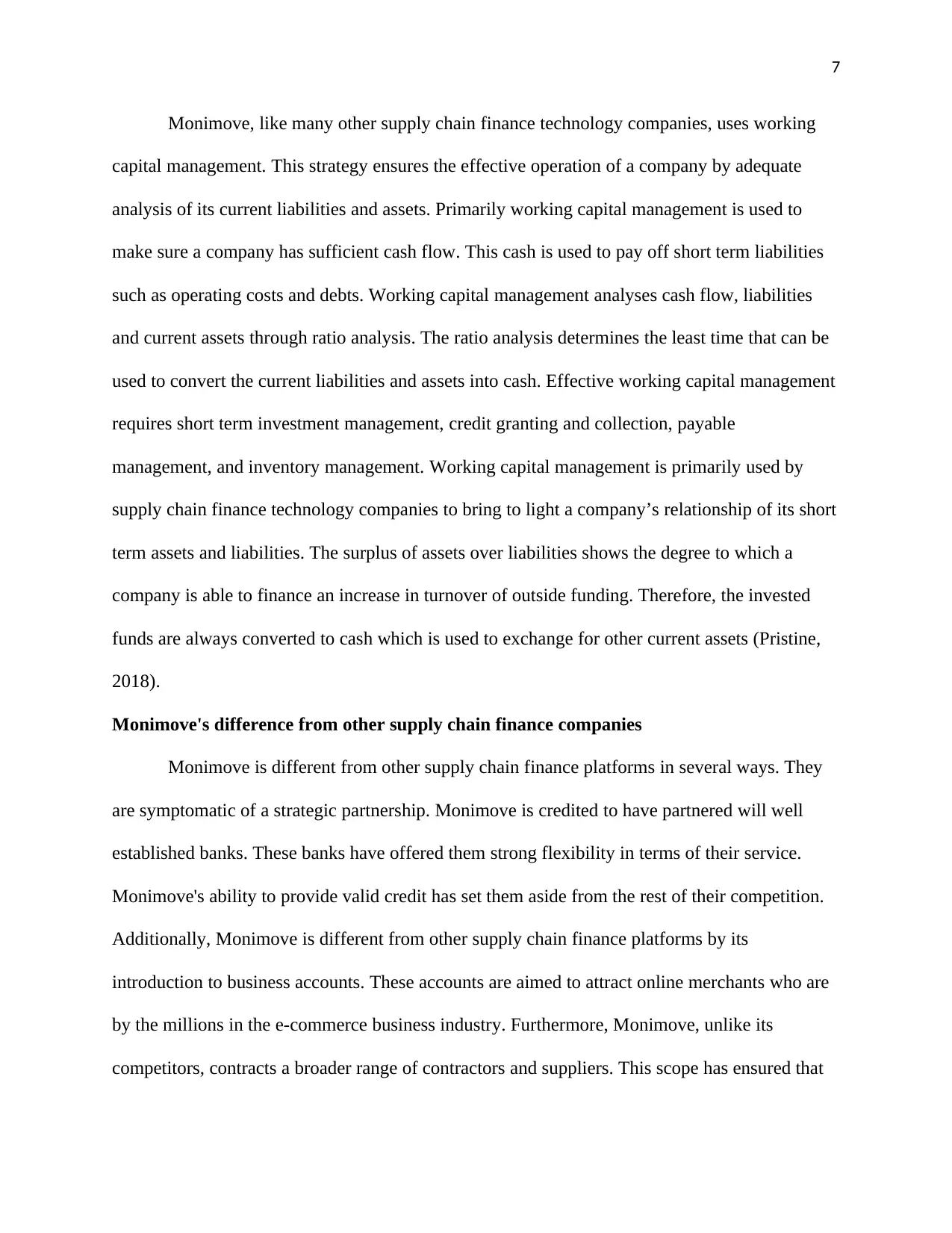
7
Monimove, like many other supply chain finance technology companies, uses working
capital management. This strategy ensures the effective operation of a company by adequate
analysis of its current liabilities and assets. Primarily working capital management is used to
make sure a company has sufficient cash flow. This cash is used to pay off short term liabilities
such as operating costs and debts. Working capital management analyses cash flow, liabilities
and current assets through ratio analysis. The ratio analysis determines the least time that can be
used to convert the current liabilities and assets into cash. Effective working capital management
requires short term investment management, credit granting and collection, payable
management, and inventory management. Working capital management is primarily used by
supply chain finance technology companies to bring to light a company’s relationship of its short
term assets and liabilities. The surplus of assets over liabilities shows the degree to which a
company is able to finance an increase in turnover of outside funding. Therefore, the invested
funds are always converted to cash which is used to exchange for other current assets (Pristine,
2018).
Monimove's difference from other supply chain finance companies
Monimove is different from other supply chain finance platforms in several ways. They
are symptomatic of a strategic partnership. Monimove is credited to have partnered will well
established banks. These banks have offered them strong flexibility in terms of their service.
Monimove's ability to provide valid credit has set them aside from the rest of their competition.
Additionally, Monimove is different from other supply chain finance platforms by its
introduction to business accounts. These accounts are aimed to attract online merchants who are
by the millions in the e-commerce business industry. Furthermore, Monimove, unlike its
competitors, contracts a broader range of contractors and suppliers. This scope has ensured that
Monimove, like many other supply chain finance technology companies, uses working
capital management. This strategy ensures the effective operation of a company by adequate
analysis of its current liabilities and assets. Primarily working capital management is used to
make sure a company has sufficient cash flow. This cash is used to pay off short term liabilities
such as operating costs and debts. Working capital management analyses cash flow, liabilities
and current assets through ratio analysis. The ratio analysis determines the least time that can be
used to convert the current liabilities and assets into cash. Effective working capital management
requires short term investment management, credit granting and collection, payable
management, and inventory management. Working capital management is primarily used by
supply chain finance technology companies to bring to light a company’s relationship of its short
term assets and liabilities. The surplus of assets over liabilities shows the degree to which a
company is able to finance an increase in turnover of outside funding. Therefore, the invested
funds are always converted to cash which is used to exchange for other current assets (Pristine,
2018).
Monimove's difference from other supply chain finance companies
Monimove is different from other supply chain finance platforms in several ways. They
are symptomatic of a strategic partnership. Monimove is credited to have partnered will well
established banks. These banks have offered them strong flexibility in terms of their service.
Monimove's ability to provide valid credit has set them aside from the rest of their competition.
Additionally, Monimove is different from other supply chain finance platforms by its
introduction to business accounts. These accounts are aimed to attract online merchants who are
by the millions in the e-commerce business industry. Furthermore, Monimove, unlike its
competitors, contracts a broader range of contractors and suppliers. This scope has ensured that
Paraphrase This Document
Need a fresh take? Get an instant paraphrase of this document with our AI Paraphraser
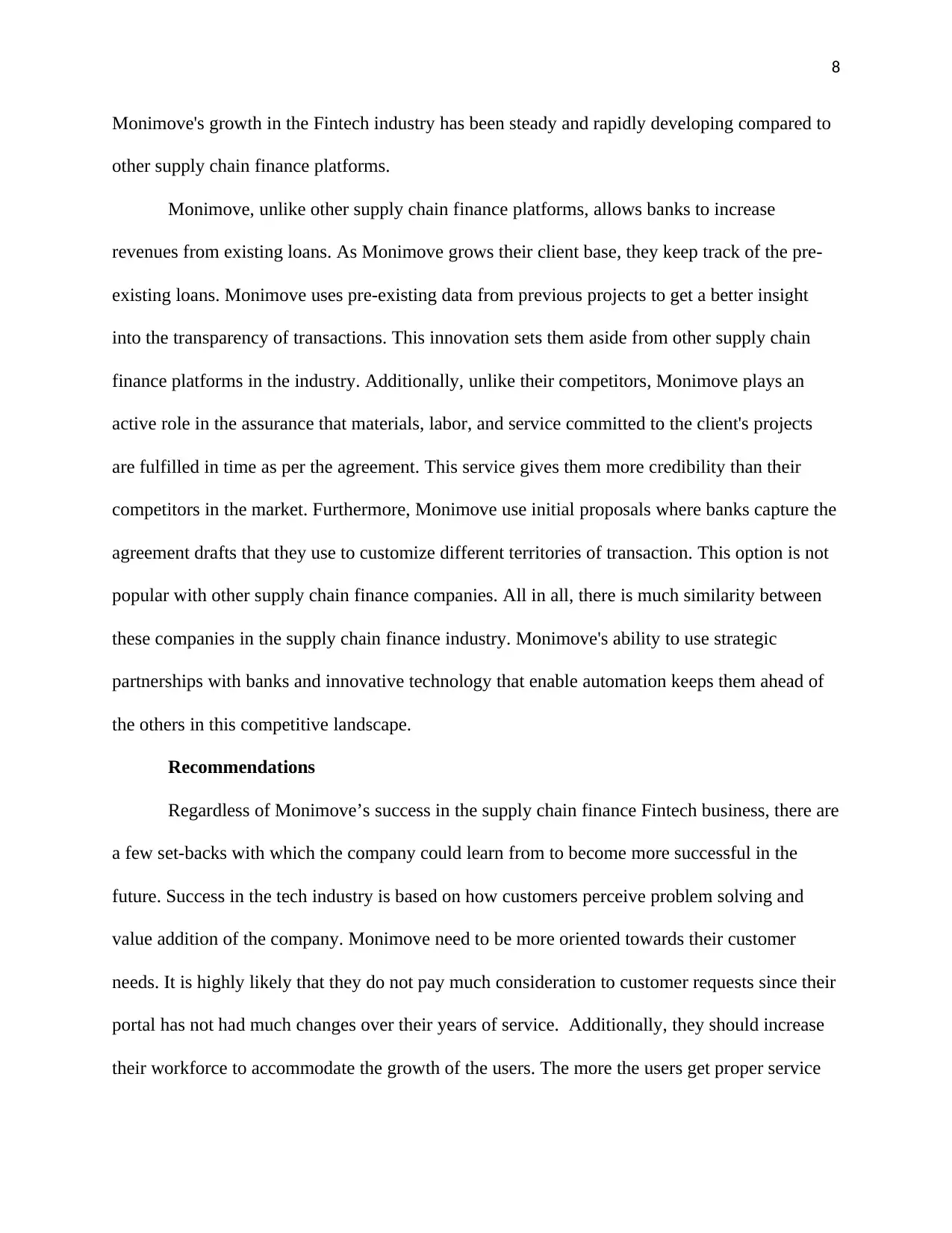
8
Monimove's growth in the Fintech industry has been steady and rapidly developing compared to
other supply chain finance platforms.
Monimove, unlike other supply chain finance platforms, allows banks to increase
revenues from existing loans. As Monimove grows their client base, they keep track of the pre-
existing loans. Monimove uses pre-existing data from previous projects to get a better insight
into the transparency of transactions. This innovation sets them aside from other supply chain
finance platforms in the industry. Additionally, unlike their competitors, Monimove plays an
active role in the assurance that materials, labor, and service committed to the client's projects
are fulfilled in time as per the agreement. This service gives them more credibility than their
competitors in the market. Furthermore, Monimove use initial proposals where banks capture the
agreement drafts that they use to customize different territories of transaction. This option is not
popular with other supply chain finance companies. All in all, there is much similarity between
these companies in the supply chain finance industry. Monimove's ability to use strategic
partnerships with banks and innovative technology that enable automation keeps them ahead of
the others in this competitive landscape.
Recommendations
Regardless of Monimove’s success in the supply chain finance Fintech business, there are
a few set-backs with which the company could learn from to become more successful in the
future. Success in the tech industry is based on how customers perceive problem solving and
value addition of the company. Monimove need to be more oriented towards their customer
needs. It is highly likely that they do not pay much consideration to customer requests since their
portal has not had much changes over their years of service. Additionally, they should increase
their workforce to accommodate the growth of the users. The more the users get proper service
Monimove's growth in the Fintech industry has been steady and rapidly developing compared to
other supply chain finance platforms.
Monimove, unlike other supply chain finance platforms, allows banks to increase
revenues from existing loans. As Monimove grows their client base, they keep track of the pre-
existing loans. Monimove uses pre-existing data from previous projects to get a better insight
into the transparency of transactions. This innovation sets them aside from other supply chain
finance platforms in the industry. Additionally, unlike their competitors, Monimove plays an
active role in the assurance that materials, labor, and service committed to the client's projects
are fulfilled in time as per the agreement. This service gives them more credibility than their
competitors in the market. Furthermore, Monimove use initial proposals where banks capture the
agreement drafts that they use to customize different territories of transaction. This option is not
popular with other supply chain finance companies. All in all, there is much similarity between
these companies in the supply chain finance industry. Monimove's ability to use strategic
partnerships with banks and innovative technology that enable automation keeps them ahead of
the others in this competitive landscape.
Recommendations
Regardless of Monimove’s success in the supply chain finance Fintech business, there are
a few set-backs with which the company could learn from to become more successful in the
future. Success in the tech industry is based on how customers perceive problem solving and
value addition of the company. Monimove need to be more oriented towards their customer
needs. It is highly likely that they do not pay much consideration to customer requests since their
portal has not had much changes over their years of service. Additionally, they should increase
their workforce to accommodate the growth of the users. The more the users get proper service
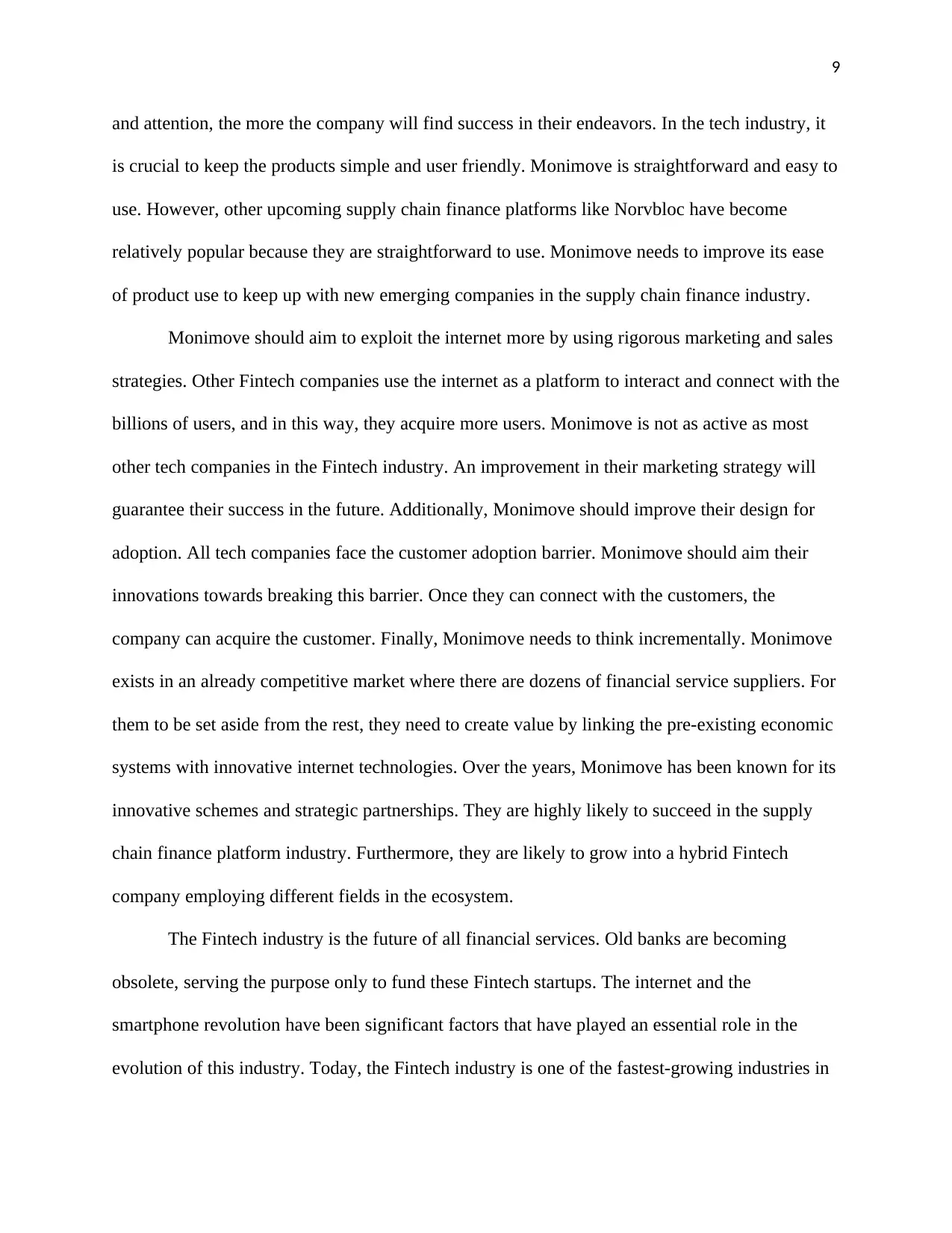
9
and attention, the more the company will find success in their endeavors. In the tech industry, it
is crucial to keep the products simple and user friendly. Monimove is straightforward and easy to
use. However, other upcoming supply chain finance platforms like Norvbloc have become
relatively popular because they are straightforward to use. Monimove needs to improve its ease
of product use to keep up with new emerging companies in the supply chain finance industry.
Monimove should aim to exploit the internet more by using rigorous marketing and sales
strategies. Other Fintech companies use the internet as a platform to interact and connect with the
billions of users, and in this way, they acquire more users. Monimove is not as active as most
other tech companies in the Fintech industry. An improvement in their marketing strategy will
guarantee their success in the future. Additionally, Monimove should improve their design for
adoption. All tech companies face the customer adoption barrier. Monimove should aim their
innovations towards breaking this barrier. Once they can connect with the customers, the
company can acquire the customer. Finally, Monimove needs to think incrementally. Monimove
exists in an already competitive market where there are dozens of financial service suppliers. For
them to be set aside from the rest, they need to create value by linking the pre-existing economic
systems with innovative internet technologies. Over the years, Monimove has been known for its
innovative schemes and strategic partnerships. They are highly likely to succeed in the supply
chain finance platform industry. Furthermore, they are likely to grow into a hybrid Fintech
company employing different fields in the ecosystem.
The Fintech industry is the future of all financial services. Old banks are becoming
obsolete, serving the purpose only to fund these Fintech startups. The internet and the
smartphone revolution have been significant factors that have played an essential role in the
evolution of this industry. Today, the Fintech industry is one of the fastest-growing industries in
and attention, the more the company will find success in their endeavors. In the tech industry, it
is crucial to keep the products simple and user friendly. Monimove is straightforward and easy to
use. However, other upcoming supply chain finance platforms like Norvbloc have become
relatively popular because they are straightforward to use. Monimove needs to improve its ease
of product use to keep up with new emerging companies in the supply chain finance industry.
Monimove should aim to exploit the internet more by using rigorous marketing and sales
strategies. Other Fintech companies use the internet as a platform to interact and connect with the
billions of users, and in this way, they acquire more users. Monimove is not as active as most
other tech companies in the Fintech industry. An improvement in their marketing strategy will
guarantee their success in the future. Additionally, Monimove should improve their design for
adoption. All tech companies face the customer adoption barrier. Monimove should aim their
innovations towards breaking this barrier. Once they can connect with the customers, the
company can acquire the customer. Finally, Monimove needs to think incrementally. Monimove
exists in an already competitive market where there are dozens of financial service suppliers. For
them to be set aside from the rest, they need to create value by linking the pre-existing economic
systems with innovative internet technologies. Over the years, Monimove has been known for its
innovative schemes and strategic partnerships. They are highly likely to succeed in the supply
chain finance platform industry. Furthermore, they are likely to grow into a hybrid Fintech
company employing different fields in the ecosystem.
The Fintech industry is the future of all financial services. Old banks are becoming
obsolete, serving the purpose only to fund these Fintech startups. The internet and the
smartphone revolution have been significant factors that have played an essential role in the
evolution of this industry. Today, the Fintech industry is one of the fastest-growing industries in
⊘ This is a preview!⊘
Do you want full access?
Subscribe today to unlock all pages.

Trusted by 1+ million students worldwide
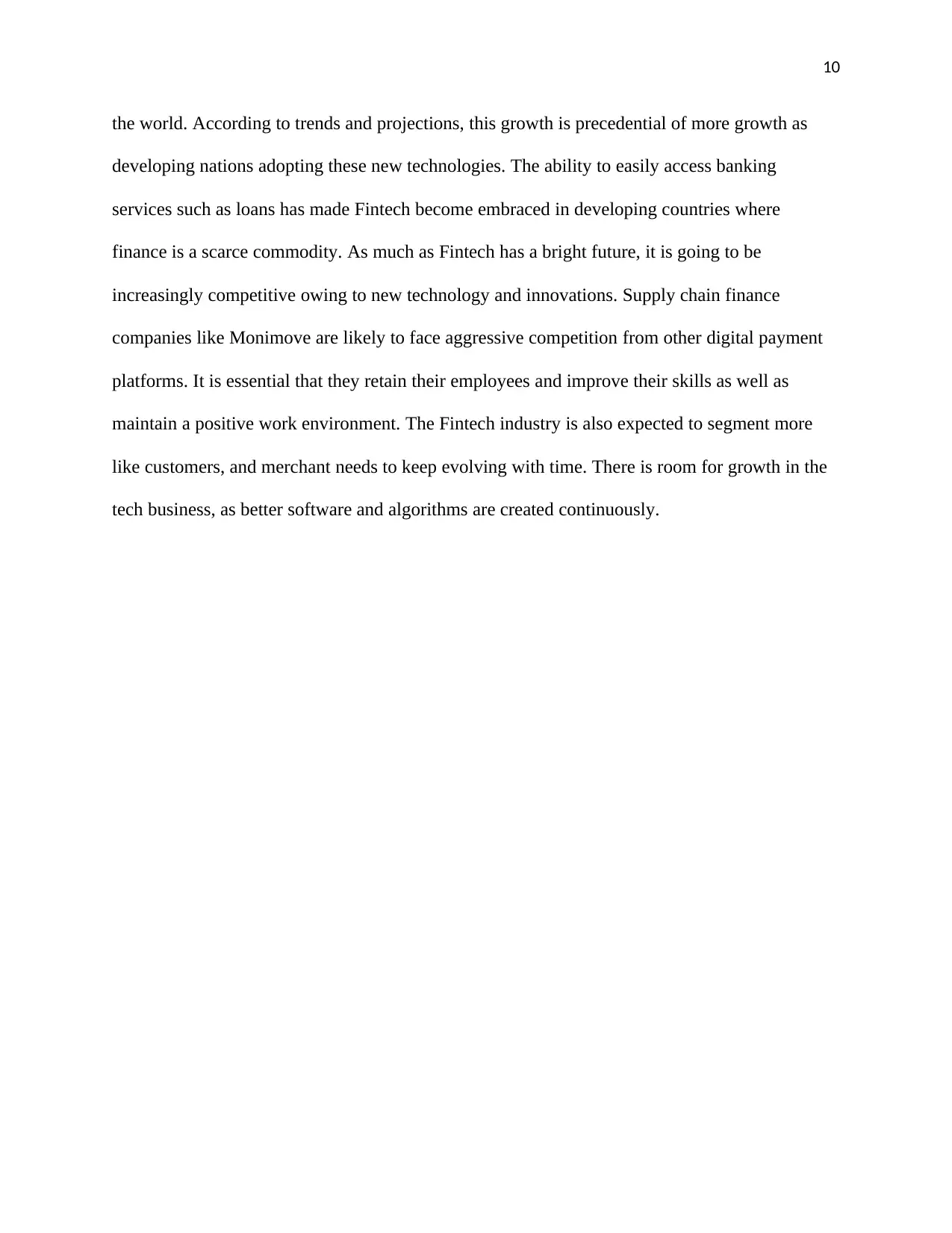
10
the world. According to trends and projections, this growth is precedential of more growth as
developing nations adopting these new technologies. The ability to easily access banking
services such as loans has made Fintech become embraced in developing countries where
finance is a scarce commodity. As much as Fintech has a bright future, it is going to be
increasingly competitive owing to new technology and innovations. Supply chain finance
companies like Monimove are likely to face aggressive competition from other digital payment
platforms. It is essential that they retain their employees and improve their skills as well as
maintain a positive work environment. The Fintech industry is also expected to segment more
like customers, and merchant needs to keep evolving with time. There is room for growth in the
tech business, as better software and algorithms are created continuously.
the world. According to trends and projections, this growth is precedential of more growth as
developing nations adopting these new technologies. The ability to easily access banking
services such as loans has made Fintech become embraced in developing countries where
finance is a scarce commodity. As much as Fintech has a bright future, it is going to be
increasingly competitive owing to new technology and innovations. Supply chain finance
companies like Monimove are likely to face aggressive competition from other digital payment
platforms. It is essential that they retain their employees and improve their skills as well as
maintain a positive work environment. The Fintech industry is also expected to segment more
like customers, and merchant needs to keep evolving with time. There is room for growth in the
tech business, as better software and algorithms are created continuously.
Paraphrase This Document
Need a fresh take? Get an instant paraphrase of this document with our AI Paraphraser
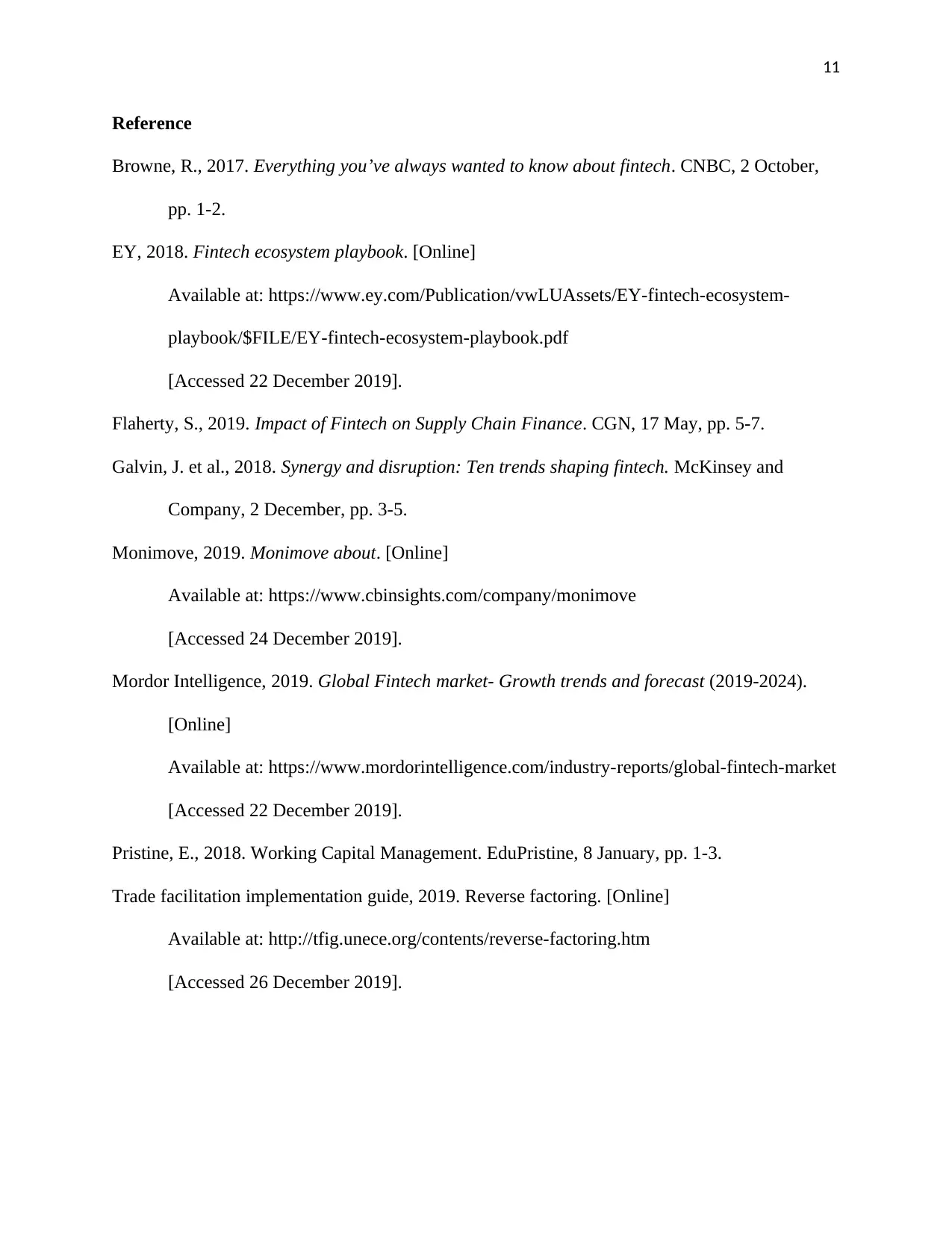
11
Reference
Browne, R., 2017. Everything you’ve always wanted to know about fintech. CNBC, 2 October,
pp. 1-2.
EY, 2018. Fintech ecosystem playbook. [Online]
Available at: https://www.ey.com/Publication/vwLUAssets/EY-fintech-ecosystem-
playbook/$FILE/EY-fintech-ecosystem-playbook.pdf
[Accessed 22 December 2019].
Flaherty, S., 2019. Impact of Fintech on Supply Chain Finance. CGN, 17 May, pp. 5-7.
Galvin, J. et al., 2018. Synergy and disruption: Ten trends shaping fintech. McKinsey and
Company, 2 December, pp. 3-5.
Monimove, 2019. Monimove about. [Online]
Available at: https://www.cbinsights.com/company/monimove
[Accessed 24 December 2019].
Mordor Intelligence, 2019. Global Fintech market- Growth trends and forecast (2019-2024).
[Online]
Available at: https://www.mordorintelligence.com/industry-reports/global-fintech-market
[Accessed 22 December 2019].
Pristine, E., 2018. Working Capital Management. EduPristine, 8 January, pp. 1-3.
Trade facilitation implementation guide, 2019. Reverse factoring. [Online]
Available at: http://tfig.unece.org/contents/reverse-factoring.htm
[Accessed 26 December 2019].
Reference
Browne, R., 2017. Everything you’ve always wanted to know about fintech. CNBC, 2 October,
pp. 1-2.
EY, 2018. Fintech ecosystem playbook. [Online]
Available at: https://www.ey.com/Publication/vwLUAssets/EY-fintech-ecosystem-
playbook/$FILE/EY-fintech-ecosystem-playbook.pdf
[Accessed 22 December 2019].
Flaherty, S., 2019. Impact of Fintech on Supply Chain Finance. CGN, 17 May, pp. 5-7.
Galvin, J. et al., 2018. Synergy and disruption: Ten trends shaping fintech. McKinsey and
Company, 2 December, pp. 3-5.
Monimove, 2019. Monimove about. [Online]
Available at: https://www.cbinsights.com/company/monimove
[Accessed 24 December 2019].
Mordor Intelligence, 2019. Global Fintech market- Growth trends and forecast (2019-2024).
[Online]
Available at: https://www.mordorintelligence.com/industry-reports/global-fintech-market
[Accessed 22 December 2019].
Pristine, E., 2018. Working Capital Management. EduPristine, 8 January, pp. 1-3.
Trade facilitation implementation guide, 2019. Reverse factoring. [Online]
Available at: http://tfig.unece.org/contents/reverse-factoring.htm
[Accessed 26 December 2019].
1 out of 11
Related Documents
Your All-in-One AI-Powered Toolkit for Academic Success.
+13062052269
info@desklib.com
Available 24*7 on WhatsApp / Email
![[object Object]](/_next/static/media/star-bottom.7253800d.svg)
Unlock your academic potential
Copyright © 2020–2025 A2Z Services. All Rights Reserved. Developed and managed by ZUCOL.





